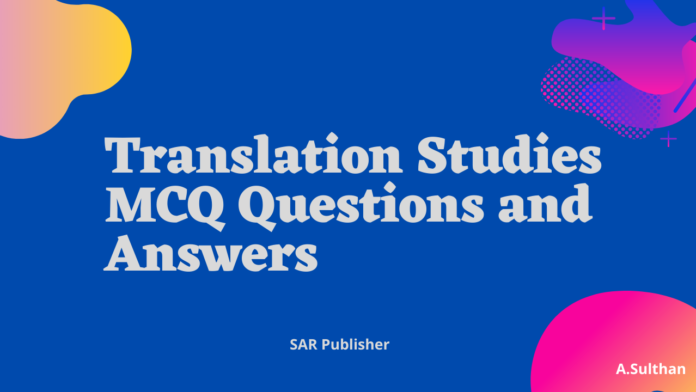Translation Studies MCQ Questions and Answers Part – 1
Translation Studies MCQ Questions and Answers Part – 2
Translation Studies MCQ Questions and Answers Part – 3
1. The word translation is derived from the ___________ ‘translatum’.
A. Latin
B. greek
C. german
D. norse
ANSWER: A
2. _____________ is the process of converting an original or “source” text into a text in another language.
A. Etymology
B. translation
C. phonetics
D. linguiustics
ANSWER: B
3. ____________is the translation within the same language.
A. interlingual
B. intersemiotic
C. intralingual
D. Transparency
ANSWER: C
4. Translation from one language to another is called ______________ translation.
A. intralingual
B. ntersemiotic
C. Pronunciation
D. interlingual
ANSWER: D
5. __________________ is the conversion of text from one script to another.
A. Transliteration
B. Transcription
C. Decoding
D. Encoding
ANSWER: A
6. ______________ is the study of sign and sign systems in language.
A. Semiotics
B. Psychology
C. Pragmatics
D. Geology
ANSWER: A
7. According to Edward Sapir, ___________ is a guide to social reality.
A. Grammar
B. Language
C. Dictionary
D. Book
ANSWER: B
8. ___________in translation is being faithful and accurate to the SL text
A. Distortion
B. Target Language
C. Fidelity
D. Source Language
ANSWER: C
9. Lack of fidelity to the text in SL can be defined as ________ in translation studies.
A. Spirit
B. syntactic
C. semantic
D. distortion
ANSWER: D
10. Traditionally the ______________ was considered inferior to the author.
A. translator
B. poet
C. narrator
D. writer
ANSWER: A
11. Jakobson declares that every poetic art is therefore technically ________.
A. translatable
B. device
C. untranslatable
D. imagination
ANSWER: C
12. _____________when translated has to be approached as a complex system rather than as a text.
A. poem
B. Drama
C. short story
D. prose
ANSWER: B
13. ___________shows that the dramatic text is inseparable from performance.
A. Ubersfeld
B. Popovic
C. Folena
D. Catford
ANSWER: A
14. _________ can be either horizontal or vertical translation.
A. Paraphras
B. Medieval translation
C. Metaphrase
D. Imitation
ANSWER: B
15. _________ is translating an author word-by-word and line-by-line from one language to another.
A. mistranslation
B. Vertical
C. Metaphrase
D. Imitation
ANSWER: C
16. Intralingual translation is also known as _______________.
A. Rewording
B. Retaining
C. Transmutation
D. None of the above
ANSWER: A
17. Roman Jacobson has distinguished ____________ types of translation.
A. 2
B. 3
C. 4
D. 5
ANSWER: B
18. Georges Mounin is a _______________ theorist.
A. German
B. Italian
C. French
D. American
ANSWER: C
19. ‘Oui’ and ‘Si’ are two usages for the word __________ in french language.
A. Hello
B. Yes
C. Good morning
D. How are you?
ANSWER: B
20. The way of translating social or cultural reality of the source text to that of the culture of the target language is called __________
A. Adaptation
B. Linguistic
C. Untranslatability
D. Calque
ANSWER: A
21. In ___________ the translator uses the word or phrase of the original, usually in italics.
A. Cultural
B. Paraphrase
C. Borrowing
D. Calque
ANSWER: C
22. In which the translation an expression is rendered word-for-word ? ________.
A. Adaptation
B. Translators note
C. Cultural
D. Calque
ANSWER: D
23. In _______________ the translator adds elements to the target texts to make up for their absence in the target language
A. Linguistic
B. Compensation
C. Borrowing
D. Adaptation
ANSWER: B
24. When a word of the source text is replaced in the target text by a whole group of words that explain a nonexistent notion in the target language, it is called _______.
A. Paraphrase
B. Compensation
C. Cultural
D. Compensation
ANSWER: A
25. A good translation is a translation that provides an __________ message of the SLtext in the target language.
A. opposite
B. equivalent
C. irrevelant
D. wrong
ANSWER: B
26. Levy is a ___________ translation scholar.
A. Czech
B. Australian
C. German
D. French
ANSWER: A
27. According to Beekman and Callow (1989), there are _______ main types of translation
A. four
B. two
C. one
D. nine
ANSWER: A
28. The problems of equivalence arises primarily in translating, __________.
A. Poems
B. Plays
C. Fiction
D. Idioms
ANSWER: D
29. ____________ distinguishes translation a ‘process’ and a ‘product’.
A. Abrecht Neubert
B. Eugene Nida
C. Levy
D. Rieu
ANSWER: A
30. _________ is another cause of loss in translation.
A. loss
B. gain
C. Untranslatability
D. lexical
ANSWER: C
31. The ____________ has been translated into many languages since ages.
A. Books
B. Bible
C. Bhagavat Gita
D. Koran
ANSWER: B
32. The New Testament was written in _________.
A. celtiic
B. norton
C. latin
D. Koine Greek
ANSWER: D
33. No two languages are ever sufficiently similar to be considered as representing the _____social reality.
A. different
B. same
C. contrast
D. divergent
ANSWER: B
34. The idea of __________ may be traced back to the 17th century.
A. Decoding
B. Re-encoding
C. machine translation
D. Interlingual
ANSWER: C
35. Machine translation can use a method based on ________ entries.
A. dictionary
B. books
C. journal
D. article
ANSWER: A
36. Translation of the _______ increased considerably in France between 1625 and 1660.
A. Scottish
B. Classics
C. French
D. English
ANSWER: B
37. The writers of 17th century turned to ancient masters, seeing in __________ a means of instruction.
A. translation
B. depiction
C. narration
D. Imitation
ANSWER: D
38. The great age of French classicism and flowering of French theatre was based on the ________.
A. Shakespearean unities
B. Aristotelian unities
C. Greek unities
D. Spencerian unities
ANSWER: B
39. Formal equivalence is also called as ___________.
A. Dynamic
B. Covering
C. Gloss
D. None of the above
ANSWER: C
40. Sir John Denhams theory of translation is expressed in his poem_____________
A. To sir John Franshawe
B. To sir Francis Franshawe
C. To sir Thomas Franshawe
D. To Sir Richard Franshawe
ANSWER: D
41. Translation of Pastor Fido was written in the year__________.
A. 1645
B. 1655
C. 1648
D. 1678
ANSWER: C
42. The Translated version of the Destruction of Troy was written in the year______________
A. 1623
B. 1656
C. 1695
D. 1685
ANSWER: B
43. The term translation studies was first put forward by_________ .
A. Lefevere
B. Destutt de Tracy
C. James Holmes
D. Bassnett
ANSWER: C
44. Denhams theory argues for a concept of translation that sees translator and the original writer as ________
A. Equals
B. opponents
C. competitor
D. rivals
ANSWER: A
45. According to Denham the duty of translator is to extract and reproduce or __________ the work in the
target language.
A. create
B. Recreate
C. emit
D. submit
ANSWER: B
46. Mukarovsky says a text should be ____________ and ____________.
A. Autonomous and Correct
B. Small and Communicative
C. Autonomous and Communicative
D. Subjective and Communicative
ANSWER: C
47. Loss and Gain are a part of ____________ process.
A. Transliteration
B. Rewording
C. Oral communication
D. Translation
ANSWER: D
48. George Steiner wrote, ____________.
A. Bible
B. Translation studies
C. After Babel
D. None of the above
ANSWER: C
49. __________ is one of the steps formulated by Dryden in tackling problems of translations.
A. Imitation
B. translation
C. depiction
D. narration
ANSWER: A
50. _______represents some changes occurring in a translation process.
A. equivalence
B. loss
C. Shift
D. gain
ANSWER: C



Nice
Sir,
I want write research in this topic can you help me to write a research in good way and find a research gap , I want select a good topic which is useful for students.